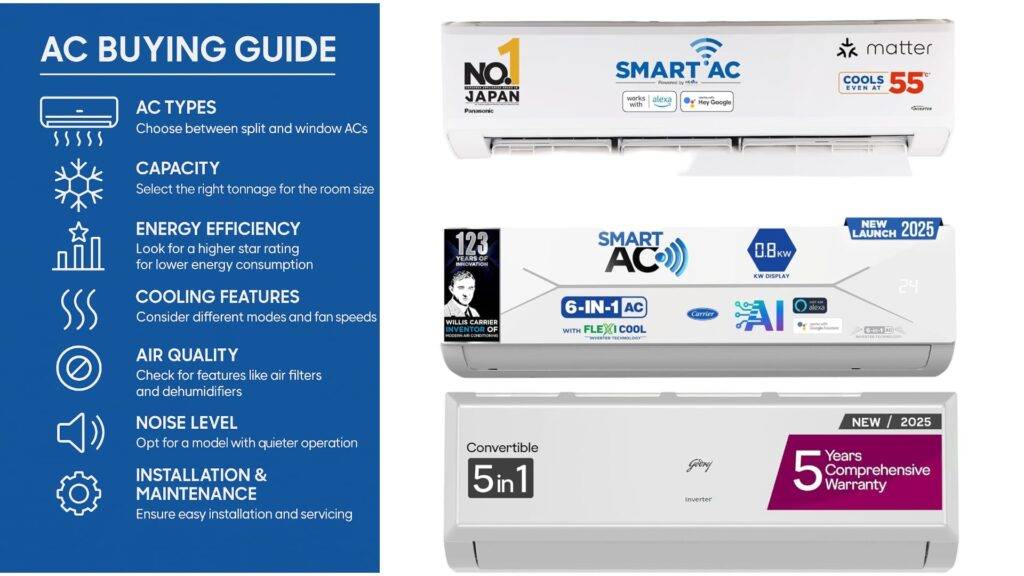Whether you’re preparing for peak summer or replacing an outdated unit, buying an air conditioner is a major decision that can impact your comfort, energy bills, and indoor air quality. With numerous options on the market, making the right choice requires understanding your needs and the technical aspects of AC systems. Here’s a complete guide on what to look for when buying an AC:
Table of contents
- 1. Determine the Right AC Type for Your Space
- 2. Check the Room Size and AC Capacity (Tonnage)
- 3. Energy Efficiency (Star Rating & ISEER)
- 4. Key Features to Look For
- 5. Noise Levels
- 6. Brand Reputation & Service Network
- 7. Warranty & AMC (Annual Maintenance Contract)
- 8. Price vs. Long-Term Value
- 9. Installation & Placement
- 10. Seasonal Promotions & Exchange Offers
- Conclusion: Choose Smart, Stay Cool
1. Determine the Right AC Type for Your Space
- Window AC: Ideal for small rooms or single spaces. Easy to install and budget-friendly.
- Split AC: Popular for bedrooms and living rooms; offers quieter operation and better aesthetics.
- Portable AC: Great for renters or those who want mobility, though often less energy-efficient.
- Inverter AC: More expensive upfront but highly energy-efficient, ideal for long-term use.
2. Check the Room Size and AC Capacity (Tonnage)
Choose an AC with the right tonnage based on your room size:
| Room Size (sq. ft) | Recommended Tonnage |
|---|---|
| Up to 120 sq. ft | 1 Ton |
| 120–180 sq. ft | 1.5 Ton |
| 180–300 sq. ft | 2 Ton |
Oversized ACs consume more power and may not dehumidify effectively. Undersized units will struggle to cool the room.
3. Energy Efficiency (Star Rating & ISEER)
- Look for a BEE Star Rating (1 to 5 stars) – higher stars mean better energy efficiency.
- Check the ISEER (Indian Seasonal Energy Efficiency Ratio) for a more accurate performance indicator.
- Inverter ACs typically have a better ISEER score and lower power consumption.

4. Key Features to Look For
- Inverter Technology: Adjusts compressor speed for efficient cooling and savings.
- Copper Coil Condenser: Offers better cooling, faster heat transfer, and is easier to maintain than aluminium coils.
- Air Filters: Helps improve indoor air quality by removing dust, allergens, and bacteria.
- Dehumidification Mode: Useful during humid weather to reduce moisture.
- Sleep Mode & Timer: Enhances comfort and saves electricity while sleeping.
- Wi-Fi & Smart Controls: Control your AC via smartphone or voice assistant.
5. Noise Levels
- A good split AC should operate below 40-45 dB indoors.
- Lower noise is especially important for bedrooms or study rooms.
6. Brand Reputation & Service Network
- Go for a reliable brand with a strong after-sales service network.
- Check user reviews and availability of quick service or spare parts.
7. Warranty & AMC (Annual Maintenance Contract)
- Ensure at least 1-year comprehensive warranty and 5 to 10 years on compressor.
- Ask about AMC packages to cover regular servicing and maintenance.
8. Price vs. Long-Term Value
- While budget is important, don’t focus only on initial cost.
- Energy-efficient models may cost more initially but save significantly on electricity bills.
9. Installation & Placement
- Proper installation impacts efficiency and longevity.
- Ensure correct placement: indoor unit should be at an optimal height, outdoor unit should be in a shaded, well-ventilated area.
10. Seasonal Promotions & Exchange Offers
- Brands often offer discounts or exchange offers during peak season (March–June).
- Buying during off-season (Winter) may save you money.
Conclusion: Choose Smart, Stay Cool
Investing in the right air conditioner isn’t just about beating the heat—it’s about efficiency, durability, and comfort. Focus on the right size, energy ratings, features, and reliable after-sales support to get the best long-term value.
Whether it’s a 1 Ton inverter AC for your bedroom or a powerful 2 Ton unit for a hall, using the above checklist will ensure your purchase is smart and future-proof.
